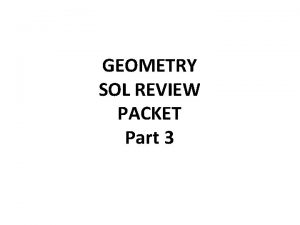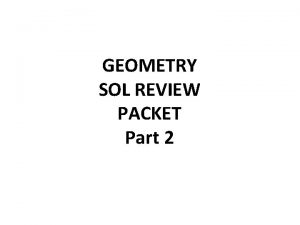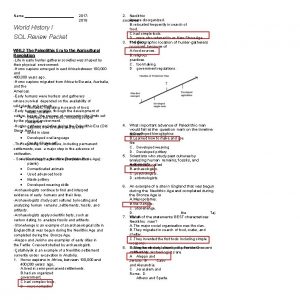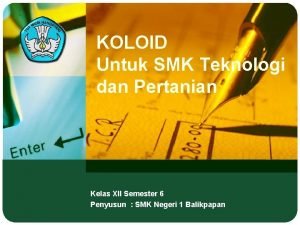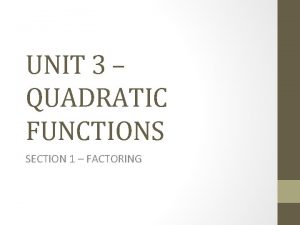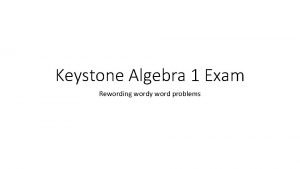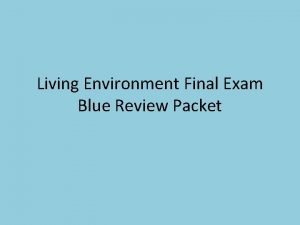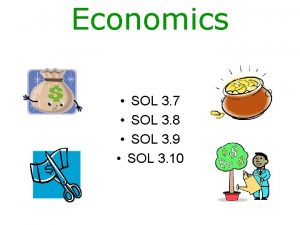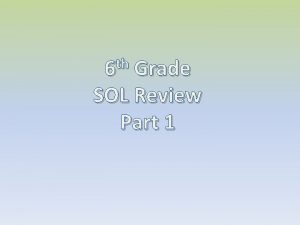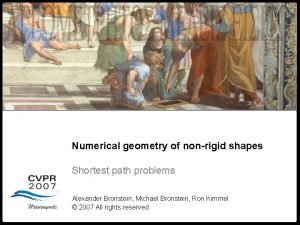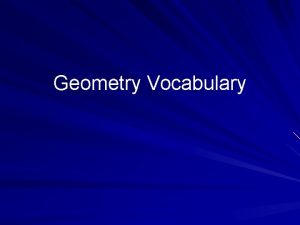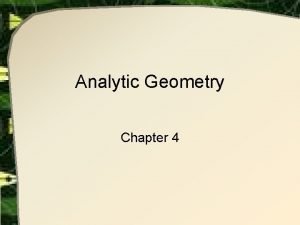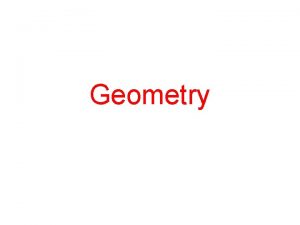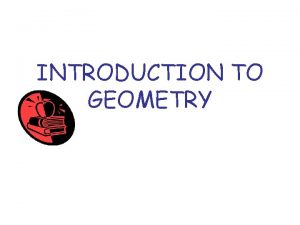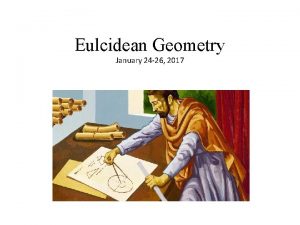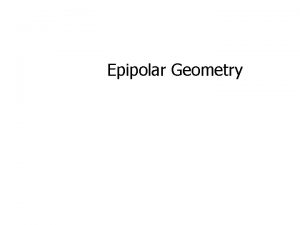GEOMETRY SOL REVIEW PACKET Part 2 What I



















- Slides: 19

GEOMETRY SOL REVIEW PACKET Part 2

What I Need to Know - Triangles Large; Small Large side is opposite large angle; small side opposite small angle Large; Small Large angle is opposite large side; small angle opposite small side Small + Small > Large The two small sides must have a total length greater than large side.

What I Need to Know - Triangles

What I Need to Know - Triangles 9 600 4 800 The 600 angle has to be opposite the 7, since that will be the middle length. The 800 angle is opposite the 9, the longest side. The only possible combination of sides is: 4, 7, and 9. These are the only measurements which make small + small > large. Since angles add up to 180, the other two angles have to be 60 and 80. Since 400 is the smallest angle, the side opposite it must be the shortest side (4).

What I Need to Know - Triangles 4 22

What I Need to Know - Triangles To find the segments, we need to know what y is. We know that the angles of a triangle add up to 1800, so set them equal to 180. 300 1060 440 The smallest angle is angle S; the shortest side will be JK, the segment opposite angle S. The middle angle is angle K; the middle side will be SJ, the segment opposite angle K. The biggest angle is angle J; the longest side will be SK, the segment opposite angle J.

What I Need to Know – Congruent Triangles SSS ASS SAS AAA ASA AAS HL Reflexive Property, Midpoint of a Segment, Symmetric Property, Transitive Property, Alternate Interior Angles, Corresponding Angles, Base Angles of Isosceles Triangle, Segment Bisector, Angle Bisector, Substitution Property Distance Formula

What I Need to Know – Congruent Triangles Corresponding Parts of Congruent Triangles are Congruent

What I Need to Know – Congruent Triangles

What I Need to Know – Congruent Triangles We have to look at the order of the letters in the congruence statement to identify corresponding sides. Side ST corresponds to side XY Side TW corresponds to side YZ Side WS corresponds to side ZX Set either of these corresponding sides equal to each other and solve for x.

What I Need to Know – Congruent Triangles We are looking the point that corresponds with point C. Since point C is 4 units away from point B, point F will be 4 units away from E. Four units away from point E is point (-4, -8). Connect the points to get a triangle that is congruent to ABC.

What I Need to Know – Congruent Triangles We are looking the point that corresponds with point C. Since point C is 4 units away from point B, point F will be 4 units away from E. Four units away from point E is point (-8, -4). Connect the points to get a triangle that is congruent to ABC. TWO ANSWERS!! (-4, -8) and/or (-8, -4)

What I Need to Know – Congruent Triangles

What I Need to Know – Similar Triangles Angle-Angle AA Side-Side SSS Side-Angle. Side SAS

What I Need to Know – Similar Triangles Corresponding sides are proportional means that if you find the scale factor of the corresponding longer sides, the scale factor of the corresponding smaller sides, and the scale factor of the corresponding medium sides, they should all be equivalent. Corresponding angles are congruent means that the angles in the same position in both triangles should have the same measure.

What I Need to Know – Similar Triangles We have to look at the order of the letters in the similarity statement to identify corresponding sides. Side AB corresponds to side DE Side BC corresponds to side EF Side AC corresponds to side DF Put the lengths of AB and DE together, since they correspond. Do the same for the lengths of BC and EF. Since side EF is half the length of side BC, we know that side DE will be half of side AB. Side AB is 36, so side EF will be 18.

What I Need to Know – Similar Triangles

What I Need to Know – Similar Triangles Angle-Angle (AA) Postulate

What I Need to Know – Similar Triangles We know that angles AFB and DFC are congruent (vertical angles). We know that angles FAB and FDC are congruent (alt. interior angles). We know that angles ABF and DCF are congruent (alt. interior angles). We have two similar triangles based on AA (Angle-Angle) Notice that while we have all three angles congruent, we only needed two to prove similarity. This is because mathematically, if two angles are congruent, the third must also be congruent (they don’t add up 180 if it’s not).
 Chemistry sol review packet
Chemistry sol review packet Geometry sol review packet
Geometry sol review packet World history ii sol review packet
World history ii sol review packet Contoh koloid liofil
Contoh koloid liofil Chapter review motion part a vocabulary review answer key
Chapter review motion part a vocabulary review answer key Settling the west part 2 packet- farming the plains
Settling the west part 2 packet- farming the plains Review packet section 1 factoring
Review packet section 1 factoring Spanish final exam review packet answer key
Spanish final exam review packet answer key Algebra keystone review packet
Algebra keystone review packet World history semester 2 final review packet
World history semester 2 final review packet Spanish 2 final exam review answer key
Spanish 2 final exam review answer key Biology keystone review packet answer key
Biology keystone review packet answer key Algebra 2 semester 2 final exam
Algebra 2 semester 2 final exam Biology keystone review packet answer key
Biology keystone review packet answer key Biology keystone review packet
Biology keystone review packet Living environment review packet
Living environment review packet Dna review packet
Dna review packet Molecular geometry of pf3
Molecular geometry of pf3 4 electron domains 2 lone pairs
4 electron domains 2 lone pairs Molecular geometry and bonding theories
Molecular geometry and bonding theories
